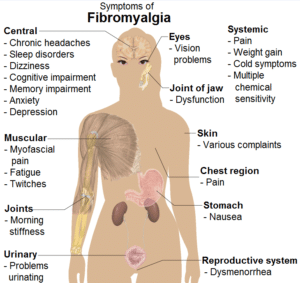Welcome to Complete Care Physio's Patient Resource About Fibromyalgia
Fibromyalgia
Fibro = fibrous tissues (ligaments that attach to bone and tendons that attach muscle to bone)
myo = muscle
algia = the Greek word for pain
People confuse between fibromyalgia and arthritis, or joint inflammation because of the symptoms. Then again, unlike arthritis, it has not affected joint or muscle inflammation and damage.
Fibromyalgia, though common, is a disease that’s not well understood. It involves pain throughout the body, with especially tender spots near certain joints. Also, the pain stops people from functioning normally, partly because they feel exhausted most of the time. Fibromyalgia is a chronic (meaning long-lasting) condition that usually requires many years of treatment. Not to mention, it can occur along with other forms of arthritis or all by itself. It can occur after an injury or out of the blue. Most people diagnosed with fibromyalgia are women in their middle years. Also, women are more likely to get fibromyalgia than men. Many people who have tension headaches or temporomandibular joint (TMJ) disorders can also get it.
Fibromyalgia’s cause remains a bit of a mystery. But, there is research that points to a number of factors that could be involved. Also, included in the research are risk factors that may increase the chance of a person developing the condition. There are many causes of the Fibromyalgia, so it is hard to find what the reason is. Researchers are looking into this mystery trying to find what is causing it. We also want to figure what is causing too.
This guide will help you understand:
- How doctors diagnose fibromyalgia
- What can be done for the condition
Anatomy
Where does fibromyalgia develop?
Pain in fibromyalgia is present in soft tissues throughout the body. Pain and stiffness concentrate on spots such as the neck and lower back. Most tests show nothing out of the ordinary in the anatomy of people with fibromyalgia. Researchers don’t know what is causing the pain and stiffness. This is a mystery to find out.
Also, you may have more cells that carry pain signals than regular. Also, you have fewer cells that that slow pain signals down. It is like a volume where is it turned all the way up. As a result, minor bumps and bruises are hurting more than they should.
Causes
Why does fibromyalgia develop?
The causes are unknown, but one thing is for sure: you’re not making it up. Many sufferers have been told that it’s all in your head by family members or other doctors. It is true that people with fibromyalgia are often depressed, and that stress worsens symptoms. But, depression and stress don’t seem to be the driving forces behind the disease.
Fibromyalgia often occurs along with other conditions, such as other forms of arthritis, Lyme disease, or thyroid problems. It can also develop after a serious injury. These problems may cause fibromyalgia to develop.
About 80 percent of all fibromyalgia patients report serious problems sleeping. Because fibromyalgia is so strongly connected to sleep disturbance. In some cases, it is possible that the sleep disturbance is the major cause. In fact, studies have produced fibromyalgia-like symptoms in healthy adults by disrupting their sleep patterns.
There is some evidence that fibromyalgia is linked with autoimmune disorders. This means your immune system attacks the tissues of your own body. Also, sufferers have lower pain thresholds and lower levels of serotonin, a brain chemical involved in pain, sleep, and mood. However, it’s unclear whether these conditions cause fibromyalgia or are a result of the disease.
Symptoms
What does fibromyalgia feel like?
The symptoms of fibromyalgia are long- lasting and intense. However, they can vary from day to day. Symptoms include:
- Pain and stiffness throughout the body, with especially tender points near certain joints
- A feeling of exhaustion that sleeps often does not help
- Sleep problems
- Tension headaches
- Numbness or tingling in the arms, hands and/or feet
- Intense PMS pains in women
- Depression
- Morning stiffness
- Poor concentration and memory loss
- Irritable bowel syndrome
- Changes in vision

Diagnosis
How do health care providers identify fibromyalgia?
Blood tests and X-rays don’t show this illness in your body. However, your health care provider may do these tests to rule out other conditions. There are only two real tools used for the diagnosis of this disease. One is your history of symptoms. The other involves putting pressure on eighteen tender point sites. If you feel pain in eleven of these eighteen sites, you may have Fibromyalgia by medical definition. (However, it is still possible that you can have the disease with pain in fewer sites.)
In some patients, doctors may recommend X-rays to look at the bones near painful spots. The X-rays will not show the condition but are used to make sure there are no other causes of your pain. Other special tests such as electromyograms, which measure the contraction of muscles. It may be used to try to determine if the muscles show abnormalities. Most of the time these tests are negative. A sleep history, and possibly a sleep study, could be important to the diagnosis.
In addition, they can look at the way it has affected your life. For example, fighting pain and fatigue can make people irritable, anxious, and depressed. Also, there is a test that can really help so if you have it. It measures the levels of proteins in the bloodstream and will help support a fibro diagnosis.
Chronic fatigue syndrome (CFS) will need to be ruled out. CFS is another disease that is difficult to diagnose and has puzzled doctors for many years. CFS shares many of the symptoms, especially severe exhaustion. The major difference is that CFS causes flu-like symptoms, such as low-grade fevers, sore throats, and swollen lymph nodes.

Our Treatment
What can be done for the condition?
Fibromyalgia is needed for medical treatment right away. This is because it is hard to manage when you have it. Different treatment is needed as each patient has different symptoms. Using painkillers might be harmful to people who have it. People who prescribed think it will stop chronic inflammation, pain, and mood shifts. We want to make sure patients who have Fibromyalgia don’t hurt themselves. This includes mentally and physically.
For many chronic and complex diseases, inflammatory blockers and painkillers have become the quick fix. For example, Fibromyalgia, MS, ALS, Parkinson’s etc.
When you visit Complete Care Physio, the first step of treatment is to help you understand this complex and frustrating disease. Many patients are relieved to learn that the disease is not all in their heads. Our physiotherapists can develop a program to help manage pain and exhaustion.
It is uncertain whether the condition is ever cured. Like many chronic diseases, the symptoms of the disease can be controlled. Successful treatment is very much a joint effort between doctor, physiotherapist and patient.
You must be willing to make lifestyle changes as well as give attention to your psychological health to help control the symptoms.
Other treatments or lifestyle changes we may recommend include:
- Exercise
- Biofeedback
- Meditation
- Acupuncture
- Pain medication
- Anti-inflammatory drugs
- Cortisone injected into painful points
- Ultrasound treatments
- Massage
- Heat for temporary pain relief
- Counselling to help deal with the symptoms
Any treatment program will likely last for many years but patients do get better. At Complete Care Physio, our goal is to help you keep your pain under control. We want you to enjoy your normal activities and lifestyle. Recent studies show that about 25 percent of patients treated for fibromyalgia was in remission at the end of two years. Many others have reduced their pain to tolerable levels.
We treat our patients like our family. Our staff will do anything to get rid of the pain you have in your body. It can physically or mentally. We want you to feel better than before. We will do anything in our power to get it done.
If you are interested in our services we have physiotherapy offices in Brampton, Oakville, and Hamilton (East Hamilton, Stoney Creek, Hamilton Mountain) that would be happy to receive you.
Portions of this document copyright MMG, LLC
